Your Guide to Modern Internet Development: Trends and Ideal Practices
In the rapidly evolving landscape of web development, understanding the most current patterns and finest methods is necessary for developing pertinent and engaging digital experiences. Key considerations such as user experience, receptive layout, and access are not merely optional but essential to the success of modern applications.
Arising Technologies in Internet Advancement
The development of internet growth is marked by a ruthless pursuit of innovation, driven by the need to boost customer experience and simplify procedures. Emerging innovations remain to reshape the landscape, offering designers effective devices to produce even more vibrant and responsive applications. Trick among these technologies are Dynamic Web Applications (PWAs), which blend the finest of internet and mobile apps, providing offline capability and boosted efficiency.
An additional substantial development is the surge of Artificial Knowledge (AI) and Device Understanding (ML), which allow individualized individual experiences and data-driven decision-making. These innovations help with chatbots, referral systems, and improved search performances, therefore changing just how individuals interact with internet applications.
Moreover, the fostering of structures like React, Vue.js, and Angular has reinvented front-end advancement, promoting modular style and reliable state monitoring. On the backside, serverless architecture and microservices cultivate scalability and versatility, enabling programmers to concentrate on creating code without managing facilities.
Value of User Experience
User experience (UX) has come to be a critical emphasis in internet growth, especially as arising technologies reshape communications. A favorable UX not only improves customer satisfaction but additionally drives interaction, retention, and conversions. ecommerce web development perth. In a significantly competitive electronic landscape, businesses have to prioritize UX to differentiate themselves and fulfill customer assumptions
Effective UX style is rooted in understanding customer needs and behaviors. This includes carrying out thorough research study, developing user identities, and utilizing functionality testing to collect insights. By doing so, developers can create intuitive user interfaces that help with seamless navigating and decrease rubbing factors.
Additionally, a well-designed UX can substantially impact a website's efficiency metrics. Researches have shown that users are a lot more most likely to abandon a website if they run into poor functionality or excessive loading times. On the other hand, a streamlined, user-centric layout can bring about reduced bounce rates and boosted time invested in the site.
Accepting Responsive Design
In today's diverse electronic landscape, accepting responsive style is vital for guaranteeing ideal user experiences throughout numerous tools. With a raising number of users accessing sites through mobile phones, tablet computers, and desktops, a responsive style technique permits content to adapt perfectly to different screen dimensions and positionings.
Responsive layout employs liquid grids, versatile images, and CSS media queries to develop a vibrant format that changes in real-time. This technique not only enhances use however also contributes to boosted search engine rankings, as online search engine prefer websites that provide a regular experience across gadgets. Additionally, receptive design reduces the need for several versions of a site, enhancing upkeep and updates.
Moreover, responsive design promotes higher interaction by using a tailored experience, keeping customers on the website much longer and decreasing bounce prices. As consumer actions remains to evolve, investing in responsive design is crucial for organizations aiming to enhance customer contentment and drive conversions. In summary, embracing receptive design is not just a pattern; it is a basic technique that straightens with the expectations of modern-day users, making certain availability and capability no matter of the tool they pick to make use of.
Availability in Web Growth
Developing a website that is both responsive and obtainable is necessary for getting to a bigger audience. Availability in internet growth makes sure that all users, regardless of their capabilities or handicaps, can effectively involve with digital content. This consists of people with visual, acoustic, cognitive, or motor impairments.
To accomplish ease of access, developers need to stick to the Web Web Content Availability Guidelines (WCAG), which offer a structure for making web material a lot more perceivable, operable, understandable, and durable. Secret practices consist of using semantic HTML components, offering alternative text for images, making sure sufficient shade contrast, and allowing keyboard navigation.
Additionally, implementing ARIA (Obtainable Rich visit this site Net Applications) attributes can boost availability, particularly for dynamic content and progressed interface. Testing with real users, including those with specials needs, is vital to identify prospective barriers and boost user experience.

The Surge of Progressive Web Apps
A substantial change in internet advancement has emerged with the rise of Progressive Internet Applications (PWAs), which flawlessly integrate the most effective functions of mobile applications and conventional sites (ecommerce web development perth). PWAs are designed to supply individuals with a fast, dependable, and engaging see here experience, no matter of their net connection. This is accomplished with service employees, which allow offline capabilities and history syncing, making sure that individuals can access material even in low-connectivity situations
PWAs additionally take advantage of responsive layout principles, ensuring that they function efficiently across a selection of gadgets and screen dimensions. This adaptability is crucial in an age where consumers increasingly count on smart phones for their online tasks. PWAs get rid of the need for separate application store setups, allowing for simpler and much more available distribution.

Conclusion
To conclude, contemporary internet advancement demands a multifaceted strategy that incorporates arising innovations, user experience, receptive style, accessibility, and the application of Progressive Web Apps. Abiding by these patterns and best methods not only enhances user engagement yet also fosters inclusivity, ensuring that electronic web content is obtainable to varied audiences. By prioritizing these aspects, programmers can produce impactful applications that meet the developing needs of customers in a significantly electronic landscape.